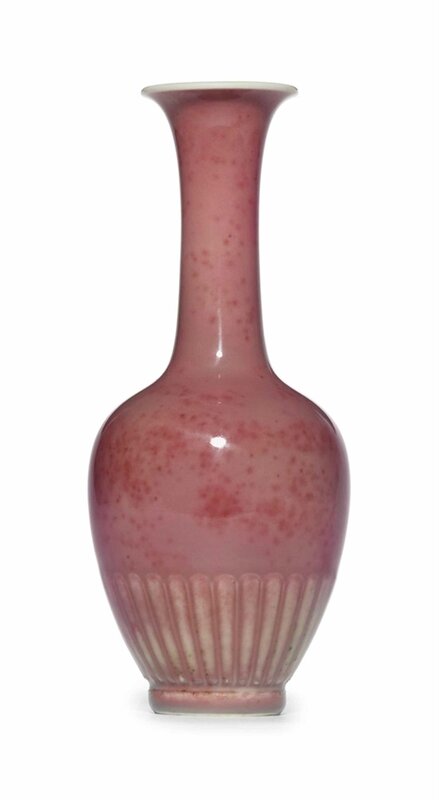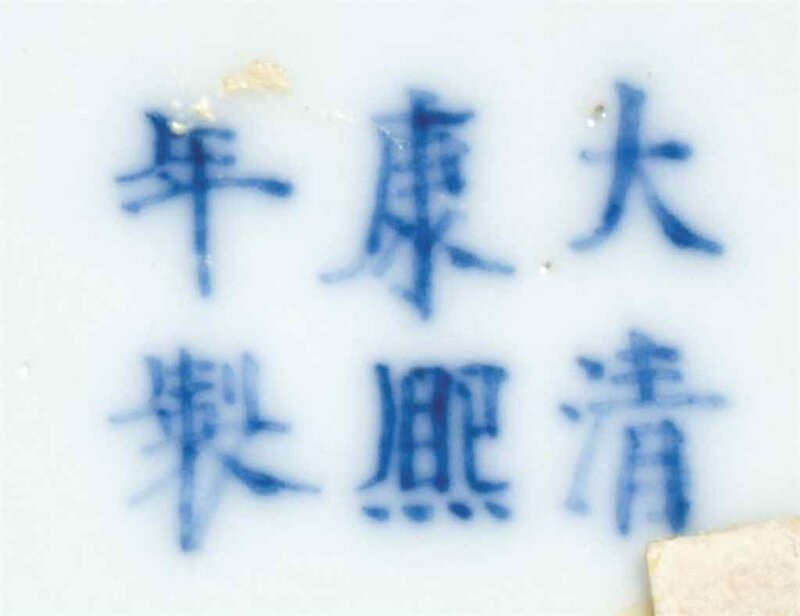A rare peachbloom-glazed 'chrysanthemum' vase,juban ping, Kangxi six-character mark in underglaze blue and of the period
Lot 913. A rare peachbloom-glazed 'chrysanthemum' vase, juban ping, Kangxi six-character mark in underglaze blue and of the period (1662-1722). Estimate USD 700,000 - USD 900,000. Photo Christie's Image Ltd 2016
The ovoid body is molded with a band of chrysanthemum petals above the ring foot, and is surmounted by a tall, trumpet-form neck. The vase is covered overall in a glaze of crushed-strawberry tone suffused with speckles running thinner on the rim and molded petals. 8 3/8 in. (21 cm.) high.
Provenance: Mary Stillman Harkness (1874-1952) Collection.
The Metropolitan Museum of Art, New York, accessioned in 1950.
Notes: This elegant vase belongs to a small, highly regarded group of vessels made during the reign of the Kangxi Emperor. Its well-balanced form, with trumpet mouth and a band of chrysanthemum petals around the base, is enhanced by one of the Qing dynasty’s most interesting and most admired glazes – a copper glaze known as ‘peachbloom’ in English and by a variety of names in Chinese, including pingguo hong ??? (apple red),jiangdou hong ??? (bean red), and meiren zui ? ?? (drunken beauty).
The peachbloom glaze, which appears to have been developed in the Kangxi reign, was applied to a limited number of relatively small vessel shapes all of which were intended for use on a scholar’s table. They have traditionally been known as the ba da ma ?? ? (Eight Great Numbers), comprised of four elegant vase forms, including the current vase form, three water pots and a seal-paste box. There are in fact four water pot forms, bringing the total to nine, rather than eight. This may be significant, since, although the number eight was traditionally regarded as lucky, the number nine is the imperial number, and it has been suggested by some scholars that these peachbloom vessels were made especially to be given as gifts from the Kangxi Emperor to favored members of the court. The style of the calligraphy used in the reign marks on peachbloom vessels has led some scholars to suggest that the vessels should date to relatively early in the Kangxi reign – AD 1678-1688 – but the sophistication of both glaze and form, as well as the discovery of one of the typical peachbloom vase forms (decorated in underglaze copper red) with the reign mark of the succeeding Yongzheng reign (AD 1723-1735), has led others to conclude that they were produced in the latter part of the Kangxi reign.
The form represented by the current vase has been the subject of much debate in regard to the correct way to describe it. In his extensive discussion of peachbloom glazed porcelains ‘The ‘Peachbloom’ Wares of the Kangxi period (AD 1662-1722)’ presented to the Oriental Ceramic Society in London in 1999 and published in Transactions of the Oriental Ceramic Society, vol. 64, 1999-2000, pp. 31-50, the British scholar John Ayers quotes Ralph M. Chait’s insistence that the vase should be described asheban ping ??? (lotus-petal vase), and Chait’s dismissal of R. L. Hobson’s description ‘chrysanthemum vase’.
It is interesting to note however that the Palace Museum, Beijing, describe their peachbloom vase of this form, as juban ping ?? ? (chrysanthemum petal vase) (see Monochrome Porcelain, The Complete Collection of Treasures of the Palace Museum, vol. 37, Hong Kong, 1999, p. 21, no. 18), as do the Shanghai Museum (Fig. 1) in their publication Kangxi Porcelain Wares from the Shanghai Museum Collection, Shanghai and Hong Kong, 1998, pp. 316-7, no. 204), while the National Palace Museum, Taipei, describe a similar vase (Fig. 2) in their collection as laifu ping ?? ? (turnip shaped vase) (see Catalogue of a Special Exhibition of Ch’ing-Dynasty Monochrome Porcelains in the National Palace Museum, Taipei, 1981, p. 39, no. 2).
Although the interpretation of the petals around the base of the vase as lotus petals would allow for Buddhist associations as well as references to harmony, purity and beauty, the long, slender shape and great number of the petals around the vase does suggest that their interpretation as chrysanthemum petals is more likely. Chrysanthemum petals would also, perhaps, have been more appropriate decoration on a vessel which was believed to have been intended for the writing table of a literatus. Chrysanthemums have been greatly admired, especially by Chinese scholars, for centuries. They were used for making wine, for making tea, for medicine, and dried chrysanthemums were put into pillows for their pleasing fragrance and their cooling effect in warm weather. In straitened circumstances, literary men such as Lu Guimeng ??? (d. AD 881) and Su Shi ?? (AD 1037-1101) also recorded eating chrysanthemums - the spring sprouts being tender and succulent, and the summer leaves and stalks being tougher and somewhat bitter. Drinking chrysanthemum wine on the 9th day of the 9th lunar month became popular as early as the Han dynasty (206 BC-AD 220). Chrysanthemums were admired by successive emperors from early times, and were grown in the imperial gardens. The Jesuit Pierre-Martial Cibot, who, in the 1770s, researched early Chinese literature relating to chrysanthemums, noted that traditionally the emperor’s plants were shaded with mats from the heat of the midday sun, and that chrysanthemums graced the imperial apartments from mid-autumn to the end of winter (see Pierre-Martial Cibot, ‘Le Kiu-hoa ou la Matricaire de Chine’, Mémoires concernant l’histoire, les sciences les arts, les moeurs, les usages, etc., des Chinois: par les missionaires de Pékin - Notices de quelques Plantes, Arbrisseaux, etc. de la Chine, Beijing, 1778, pp. 455-61).
As early as the 7th century BC, flowers in early Chinese poetry were used as symbols of female beauty and of scholarly rectitude, reclusion and nobility. Interestingly, unlike most other flowers, chrysanthemums are not usually associated with women, but with men of strength, integrity and nobility – no doubt in part because their elegant flowers are the only ones to survive the icy winds that herald the onset of winter. The Northern Song dynasty philosopher Zhou Dunyi ??? (AD 1017-73), in his famous work ‘On a Passion for Lotus’ (Ailian shuo ???), says that he believes that the chrysanthemum is the recluse amongst flowers, comparing it to the over-popular peony. Chrysanthemums are specifically mentioned in the Shijing and in Qu Yuan’s ?? (343-278 BC) poemLi Sao ?? (Encountering Sorrow). The chrysanthemum is regarded as one of the ‘four gentlemen’ ?? ? of plants, along with prunus, orchid and bamboo, which also symbolize nobility of character. Through their association with certain literary figures, chrysanthemums became symbols of Confucian scholars who refused to compromise their principles and often retreated to a rural existence far from political intrigue. Perhaps the literary figure most closely associated with chrysanthemums is Tao Yuanming ??? (AD 365-427) who is known for his love of these flowers, and who has been depicted with them in paintings from at least as early as the Song dynasty (AD 960-1279).
Chrysanthemums appear as decoration on Chinese ceramics at least as early as the Northern Qi period (AD 550-577). While lotus was the dominant floral motif in this and the succeeding Sui and Tang dynasties, sprigmolded chrysanthemum blossoms adorn the second register of the neck of a Northern Qi celadon-glazed vase in the collection of the Palace Museum, Beijing (illustrated in Porcelain of the Jin and Tang Dynasties, The Complete Collection of Treasures of the Palace Museum, vol. 31, Hong Kong, 1996, pp. 62-3, no. 57). Chrysanthemums also appear among the sprigged motifs in the lowest register of decoration on a Tang dynasty ewer in the same collection (illustrated ibid., p. 176, no. 162). Chrysanthemums provided inspiration for Chinese potters from then onwards, and reached a peak of popularity in the reigns of the three great Qing emperors – Kangxi, Yongzheng and Qianlong.
The peachbloom glaze itself is of particular beauty and technical complexity. It has been the focus of scientific research since the mid-20th century. Both the overall soft pinkish-red of the glaze, and the areas of clear green which appear to a greater or lesser extent within it owe their hue to copper. Firing in a reducing atmosphere creates the red color, while re-oxidation creates the green. This was therefore a glaze which had to be applied very precisely and fired with great care. Research suggests that a copper-lime pigment was applied between two layers of colorless glaze. The copper-lime pigment was applied by blowing through a bamboo tube with fine silk gauze over the end, to achieve an effect similar to modern spraying techniques. This allowed the thickness of the copperlime layer to be adjusted so that some areas would be thicker than others. In those thicker areas there was additional flux, which thinned the upper glaze layer and allowed the copper to re-oxidise and produce clear green. In the other areas, some of the pigment was undissolved in the glaze making it appear slightly opaque and yet smooth on the surface, while the majority of the copper did dissolve and produced a rich pinkish-red, and creating one of the most highly esteemed glazes from the Qing imperial kilns.
Rosemary Scott
International Academic Director
Christie's. Collected in America: Chinese Ceramics from The Metropolitan Museum of Art, 15 September 2016, New York, Rockefeller Plaza

/https%3A%2F%2Fprofilepics.canalblog.com%2Fprofilepics%2F1%2F0%2F100183.jpg)
/https%3A%2F%2Fstorage.canalblog.com%2F03%2F02%2F119589%2F96711876_o.jpg)
/https%3A%2F%2Fstorage.canalblog.com%2F11%2F31%2F119589%2F94773502_o.jpg)
/https%3A%2F%2Fstorage.canalblog.com%2F20%2F83%2F119589%2F94772815_o.jpg)
/https%3A%2F%2Fstorage.canalblog.com%2F26%2F72%2F119589%2F75604929_o.jpg)
/https%3A%2F%2Fstorage.canalblog.com%2F59%2F60%2F119589%2F26458628_o.jpg)




/http%3A%2F%2Fstorage.canalblog.com%2F70%2F49%2F119589%2F113206633_o.jpg)
/http%3A%2F%2Fstorage.canalblog.com%2F41%2F99%2F119589%2F112963826_o.jpg)
/http%3A%2F%2Fstorage.canalblog.com%2F57%2F83%2F119589%2F112309628_o.jpg)
/http%3A%2F%2Fstorage.canalblog.com%2F76%2F41%2F119589%2F112288255_o.jpg)